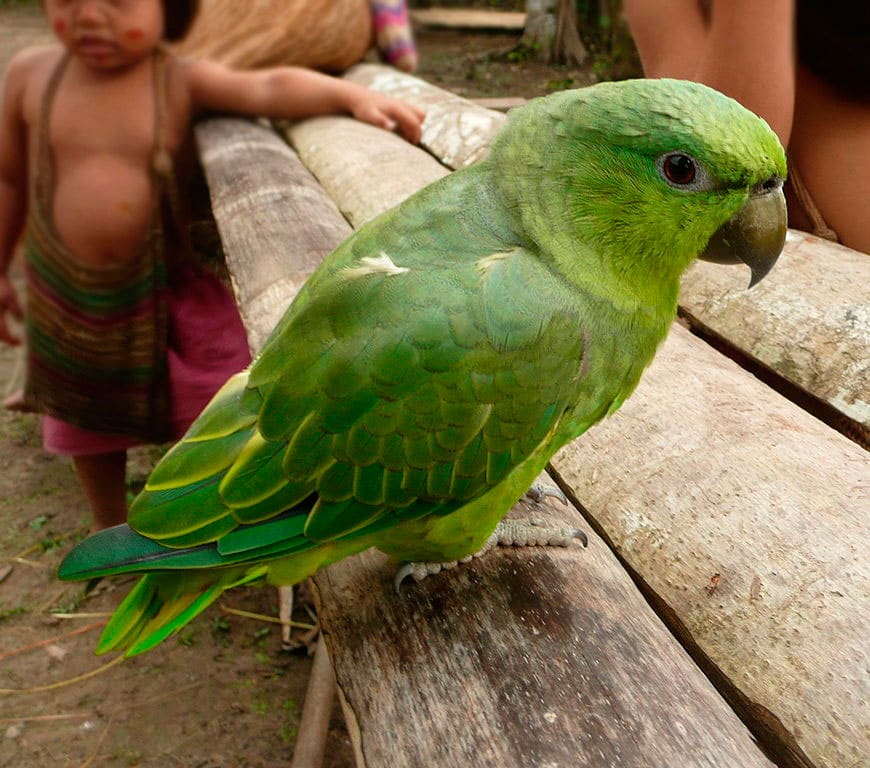Content |
|---|
Description:
23 to 24 cm.. height and between 188 and 233 g. weight.
The short tail Short tailed Parrot (Graydidascalus brachyurus) It is the most distinctive, although it is also known the eyes red orange.
generally green, somewhat yellowish on wing and the belly; Flying red noted in the base of the outer feathers tail and a small upper portion of wing towards the armpit.
The beak is greenish gray, large.
The sexual dimorphism in this species it is absent.
This species, the only one of the genre Graydidascalus, is related with the Yellow-faced Parrot (Alipiopsitta xanthops), own kind of Bolivia and Brazil.
- Sound of the Short tailed Parrot.
Habitat:
It inhabits in swampy forests, intervenidas, River Islands, borders of humid and semi-humid forest, until the 400 m, associated with river banks.
Fly quickly in large groups of up to 50 individuals, is very noisy and visit populated places. They are very social outside the breeding season. It will associate with other species of parrots in the wild.
Reproduction:
With plays during the last quarter of the year.
Successes captive breeding have not yet been registered; although several females put one or two eggs, but no chicks. In its natural habitat, the clutch average consists of 3 to 4 eggs. The period of incubation is of 24 to 25 days.
Food:
Consume large variety of fruits (very fond of guava), tubers and possibly berries, seeds, sprouts and flowers. Foraging in the treetops.
Distribution:
Size of the area of distribution (reproduction / resident): 3.870.000 km2
Its population is distributed among the rivers of the southeast of Colombia, east of Ecuador, northeastern Peru and northern Brazil, on Basin Amazon.
Conservation:
• Current category of the Red List of the UICN: Least concern.
• Population trend: Decreasing.
Justification of the population
The population size World has not been quantified, but this species is described as “quite common” (Stotz et to the., 1996).
Justification of trend
It is suspected that this species has lost 19.1-20.4% of habitat within its distribution over three generations (15 years) based on a model of Amazon deforestation (Soares-Filho et to the., 2006, Bird et to the., 2011). Given the susceptibility of the species to hunting and / or capture, you suspect your decrease in population <25% over the next three generations.
"Short tailed Parrot" in captivity:
Rare in captivity. Young people are susceptible to stress and disease.
Alternative names:
– Short-tailed Parrot, Short tailed Parrot (English).
– Caïque à queue courte, Perroquet à queue courte, Perroquet nain de Panama (French).
– Kurzschwanzpapagei, Kurzschwangenpapagei (German).
– curica-verde, curica-pequena, curiquinha, papagainho-verde (Portuguese).
– Cotorra Colicorta, Cotorrita Cabezona, Lorito Colicorto (español).
– Cotorra Colicorta (Colombia).
– Loro de Cola Corta (Peru).
scientific classification:
– Order: Psittaciformes
– Family: Psittacidae
– Genus: Graydidascalus
– Scientific name: Graydidascalus brachyurus
– Citation: (Temminck & Kuhl, 1820)
– Protonimo: Psittacus brachyurus
Images “Short tailed Parrot”:
Videos "Short tailed Parrot"
“Short tailed Parrot” (Graydidascalus brachyurus)
Sources:
- Avibase
- Parrots of the World – Forshaw Joseph M
- Parrots A Guide to the Parrots of the World – Tony Juniper & Mike Parr
- Birdlife
- Parrot Book, Parrots and macaws Neotropical
-
Photos:
(1) – IBC.lynxeds.com
(2) – Peruvian Indians with Short-tailed Parrot (Graydidascalus brachyurus) By derivative work: Snowmanradio (talk)Peruvian_Indians_with_Short-tailed_Parrot-6.jpg: Shea Hazarian [CC BY 2.0], via Wikimedia Commons
(3) – Plate 155. Psittacus viridissimus. Green Parrot. Modern accepted name (2012) is Graydidascalus brachyurusBy William Swainson, F.R.S., F.L.S. (Zoological Illustrations, Volume III.) [Public domain], via Wikimedia Commons
- Sounds: controles-canto.org




